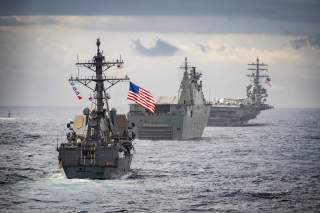The U.S. Navy Has Big Plans to Stop Any Attack Against One of Its Warships
Not what you think.
(Washington, D.C.) If enemy cruise missiles, helicopter gunfire and even fighter-jet launched bombs close in on Navy surface ships at sea, service commanders could employ a range of time-sensitive layered defenses to include interceptor missiles, deck-mounted guns, electronic warfare tactics and even lasers. Navy preparations for this kind of scenario include the use of radar, long-range sensors and coordinated surveillance with surface, undersea and air assets - all seemingly operated for rapid response-enabled destruction of incoming enemy fire.
Virtually all of these contingencies rely upon an often overlooked area of maritime warfare -- information warfare. Targeting data for pretty much any defensive weapons system would need to precede or inform fire control systems and certain kinds of sensor-weapons fusion. For this reason, the Navy is revving up its focus on training a new generation of information warriors to surge into future decades, hopefully armed with the technical skills needed to counter enemy attacks today and 20 years from now.
This focus, according to a Navy report, is taken up by the Navy’s Center for Information Warfare Training (CIWT), a particular program apparatus aimed at better synthesizing information warfare with combat sensitive data organized by Intelligence Specialists (IS).. In total, the center trains more than 21,000 students
“An IS Sailor is responsible for tracking targets in real-time, defending ships against inbound threats, and operating computer and communications equipment across the fleet,” the report states. Threats based on cutting-edge technology naturally increase the complexity of needed responses.
These kinds of missions, heavily reliant upon information warfare, often employ sophisticated cyber and electronic weapons techniques intended to discern actual incoming threats from other nearby moving objects or structures. Many incoming electronic warfare or cyberattacks, for instance, may need to be decrypted or isolated from surrounding frequencies and data. Narrowing electronic signatures with greater methods of delivery and precision are a crucial area of modern information warfare focus. A widely dispersed electronic signal can more easily be detected by an enemy, thereby giving away sensitive location information. A more narrowly focused electronic beam, however, can achieve the desired warfare impact while decreasing the risk of detection. Industry developers, such as CACI, are now increasingly looking at the possible use of signals intelligence systems (SIGNT) to help achieve this.
Cyber attacks, which often consist of phishing, denial of service or malware embedding, run the risk of derailing entirely networked and interwoven weapons system. Identifying and destroying these kinds of attacks is heavily focused upon in the training because while engineering more weapons to be interconnected and cyber-reliant, technology developers simultaneously introduce new advantages and risks. An isolated point of entry, for instance, might increase vulnerability across an entire network.
The goal is to find and “Jam” what’s called a “line of bearing,” specifying the location, speed, size and trajectory of incoming attacks. With this in mind, the Navy report states “CIWT is responsible for training enlisted cryptologic technicians, information systems technicians, intelligence specialists, and electronics technicians. CIWT also provides training to cryptologic warfare, information professional, intelligence, and foreign area officers that prepares them to be prepared to wage battle.”
One CIWT Intelligence Specialist Training Manager, Petty Officer 1st Class Philip Burrow, is tasked with understanding and imparting various complexities inherent to Information Warrior challenges. A key element, according to Burrow, is to use available technical assets to quickly gain “knowledge of the enemy.”
Knowledge of the enemy can provide the basis of information warfare-inspired deception techniques; these can consist of a range of variable to include cyber, electronic, radio or even “kinetic” weapons to confuse, disorient or deceive the enemy. This could involve emitting an electronic signal from a phony location, firing weapons from "dummy" locations or even engineering an entire ship with radar-eluding stealth configurations - as is the case with the Navy's Zumwalt-class destroyers.
Osborn previously served at the Pentagon as a Highly Qualified Expert with the Office of the Assistant Secretary of the Army - Acquisition, Logistics& Technology. Osborn has also worked as an anchor and on-air military specialist at national TV networks. He has appeared as a guest military expert on Fox News, MSNBC, The Military Channel and The History Channel. He also has a Masters Degree in Comparative Literature from Columbia University.

